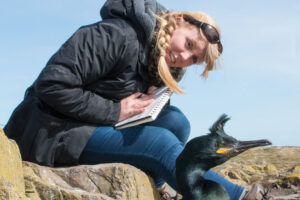Building on this strong impact, the Natural Environment Research Council (NERC) is leading investments that will drive a shift to a green, low-carbon economy, that embeds environmental considerations into our:
- businesses
- financial services
- nature conservation.
Nature is critical for human existence, economic prosperity, and a good quality of life. The ecosystem services on which we depend, such as pollination of our crops and regulation of our climate, are underpinned by nature.
Nature is worth £1.2 trillion plus to the UK economy, and we rely on it to boost our health and wellbeing.
Yet nature is under threat. One million species are currently at risk of extinction, including 15% of all UK species. To address this, the UK government has committed to restoring nature, with targets to halt British species loss, and protect 30% of terrestrial land and our oceans by 2030.
Faced with pressing problems including climate change, land use change and pollution, meeting these ambitious targets requires cutting-edge science and multidisciplinary problem solving.
Research must drive a shift to a green, low-carbon economy, that embeds environmental considerations into our businesses, financial services, and nature conservation.
About the research
Decades of NERC investment in long-term, large-scale environmental science research and innovation, infrastructure, monitoring, training, knowledge exchange and partnership has delivered:
- detailed, long-term datasets of species numbers and the features of ecosystems
- cutting edge science, informed through improving our understanding of biodiversity, ecosystem processes and the services they support
- world-leading research, predictive models and technology to identify nature’s boundaries, improve conservation management decisions, and generate alert systems for threats
- skilled people and engaged citizens
- effective partnerships with governments and industry.
Key avenues of research
Key avenues of research include the below.
Long-term monitoring of nature
Long-term biodiversity monitoring provides baseline population data that underpin policy and decision-making and engage citizen scientists.
The Biological Records Centre, recording UK soil, animal and plant life since 1964, underpins UK biodiversity policy and monitoring.
Isle of Rum deer study since 1972, now providing ground-breaking insight into genetic responses to climate change.
Isle of May seabird study since 1973, supporting expansion of the UK’s offshore wind industry.
Find out more about the Biological Records Centre.
Find out more about the Isle of May Long Term study.
Earth observation
Satellites offer huge potential for biodiversity research and monitoring, enabling much larger areas of the Earth to be analysed at a fraction of the cost and with less disturbance to nature.
The British Antarctic Survey (BAS) has developed techniques to count populations of species in hard to reach areas such as Antarctica from satellite images, which are now widely used to inform conservation.
New radar technology developed by the National Centre for Earth Observation will allow satellite mission BIOMASS to accurately weigh the wood in the world’s forests, thus mapping deforestation and informing payment for ecosystem services schemes.
The UK Centre for Ecology and Hydrology’s Land Cover Maps use satellite imagery to map grassland, woodland, fresh water and urban areas. The maps underpin land-use decisions and natural capital accounting in the UK.
Find out more about BAS’s wildlife from space research.
Find out more about the BIOMASS satellite mission.
Big data for biodiversity
NERC-funded facilities and research allow biodiversity data to be processed at unprecedented scales for more accurate pictures of biodiversity trends.
Supercomputing capability at the Centre for Environmental Data Analysis (CEDA) JASMIN facility has allowed models of UK wildlife population trends to be created from huge datasets.
The ForestPlots portal enables the worldwide study of forest health via a collaborative online tool. 2500 researchers have recorded 5.5 million tree measurements.
Find out more about the CEDA JASMIN supercomputing facility.
Find out more about the researcher, Professor Oliver Phillips FRS.
Recent investments
Recent investments include:
- Valuing Nature programme, £7 million plus, NERC-led with the Department for Environment Food and Rural Affairs (Defra) and other UK Research and Innovation (UKRI) councils, 2013 to 2019
- Ecosystem Services for Poverty Alleviation programme, £40 million, NERC-led with the Economic and Social Research Council (ESRC) and the Department for International Development, 2009 to 2018
- Biodiversity and Ecosystem Services programme, £13 million, 2011 to 2017.
Impacts of the research
Underpinning international commitment and action
NERC-funded science informs international policies that empower and encourage international governments, businesses, non-governmental organisations (NGOs) and communities to collaborate to conserve nature. It does this while helping the UK meet its international conservation commitments and deliver net zero.
Examples include the below.
Catalysing global conservation action
NERC-funded researchers led the development of the International Union for Conservation of Nature’s (IUCN) Red List of Threatened Species. It is the world’s foremost tool for assessing the conservation status of animal, fungi and plant species, and currently includes over 138,000 species.
The Red List improves conservation outcomes, informs policy decisions, and allows conservation progress to be measured and celebrated. Listed critically endangered bird species, for example, are twice as likely to improve in status as they are to deteriorate and become extinct.
Bringing biodiversity leadership to the IPCC
NERC science and scientists play a key role in the reports of the Intergovernmental Panel on Climate Change (IPCC). These influence and underpin the climate policies of national governments, and landmark agreements such as the Paris Agreement in 2015.
87% of UK-based authors of the latest IPCC Working Group 1 Assessment Report were NERC, covering topics including the impact of climate change on:
- biodiversity
- invasive species
- ecosystem services.
Bridging science and global policymaking
NERC-funded scientists contribute to the influential Intergovernmental Science-Policy Platform on Biodiversity and Ecosystem Services assessments, including the landmark Global Biodiversity Assessment 2019.
These reports provide consensus on the latest biodiversity conservation science and inform actions by international bodies such as the UN and the:
- Convention on Biological Diversity
- national governments
- businesses
- non-government organisations.
Taking stock of nature for UK policy
NERC-funded monitoring, research and experts underpin UK environment policy too, including the current 25 Year Environment Plan.
Our science played a prominent role in the UK National Ecosystem Assessment (NEA), for example, which was a world first.
By quantifying the value of natural assets, the NEA promoted the uptake of natural capital accounting, and empowered the government to create markets enabling the private sector to invest in protecting the environment.
Techniques for valuing nature have since been included in the Treasury Green Book, which defines appraisal procedure for government investments.
Enabling resilient, sustainable industries
NERC-science strengthens industry resilience and sustainability, while supporting livelihoods and protecting threatened wildlife and habitats.
Some examples are below.
Building back greener with bees
NERC-funded research revealing drastic declines in wild insect pollinator species caused by neonicotinoid pesticide use in agriculture underpinned UK and EU bans. Safeguarding £430 to £603 million worth of ecosystem services delivered to UK farms, as well as the biodiversity they support.
Insect population data has spearheaded the government’s UK National Pollinator Strategy, and inspired public engagement in pollinator science initiatives, such as the National Pollinator Monitoring Scheme.
Supporting million-pound UK industry by knowing nature’s limits
The UK rat control market, worth £230 million annually to the UK economy, can operate thanks to NERC-funded monitoring that ensures the use of rodenticides stays safe for wildlife.
By measuring the exposure of birds of prey such as owls and red kites to rat poison, scientists inform the industry of the safe limits of their use, allowing continued protection of crops and human-health, while safeguarding wildlife.
Natural England said:
The Predatory Bird Monitoring Scheme is the best example of wildlife monitoring and exposure (to chemicals) that measures changes to the environment as a result of policy intervention.
Growing renewable energy while protecting marine life
Long-term research on marine mammals and seabirds is enabling the rapid expansion of the UK’s offshore wind industry.
The sector creates green jobs in coastal communities, and is a key part of the UK’s journey to net zero carbon emissions.
Long-term NERC science underpins government and industry work on:
- wind farm locations
- assessments
- construction
- mitigation.
Now the world’s largest, UK offshore wind powers 7.5 million UK homes and is planned to increase fourfold by 2030.
Planting biodiversity into palm oil production
Half a million hectares of forest have been conserved across several countries thanks to a toolkit developed by a NERC-funded scientist. The tool calculates the minimum rainforest area needed to conserve biodiversity near palm oil plantations.
The methods have been adopted by key players in the palm oil, rubber, paper and cocoa sectors and have been incorporated into the Roundtable on Sustainable Palm Oil certification process, allowing a simpler process that enables increased participation by smallholders.
Providing joined up solutions for biodiversity and net zero
NERC science delivers innovative nature based solutions that address the joint crises of biodiversity loss and climate change, by integrating biodiversity into the economy, catalysing climate action, and delivering benefits to the:
- economy
- society
- environment.
Examples include the below.
Cutting business carbon by protecting peatlands
NERC scientists, working with the IUCN, developed the Peatland Code (PDF, 3.6MB), the UK’s first regulated scheme for businesses to support peatland restoration projects using carbon finance.
Peatlands are the world’s largest carbon sink on land, playing a vital role in storing climate-warming carbon dioxide (CO2). Three billion tonnes of carbon currently locked away in UK peatlands.
The scheme aims to restore two million hectares of UK peatland by 2040. Four projects are already underway, equating to reductions of 102 thousand tonnes of CO2.
Defra said:
This research has made a considerable contribution and provided us with valuable lessons for the development of Payment for Ecosystem Service schemes in the UK.
Valuing nature for climate-clever policies
NERC-funded research measured the benefit of healthy marine habitats to fisheries, climate and flood defence in Sussex. This resulted in a byelaw to protect, and ban trawling in, 117 square miles of seabed, allowing key habitats such as kelp forests to recover.
Kelp is an example of ‘blue carbon’, helping to combat climate change by storing CO2 as it grows.
Protecting tropical forests and mitigating climate change
Innovations in measuring and modelling carbon storage and deforestation funded by NERC are enabling managers of tropical forests to be supported through global payment for ecosystem services schemes like REDD+.
For instance NERC-funded scientists identified a technique for measuring tree biomass accurately from space. This played a key role in the European Space Agency’s decision to build a new satellite called Biomass, which is being built by Airbus Defence and Space (UK) and is due to launch in 2023.
By accurately quantifying changes in tropical forests, the satellite will enable carbon reduction schemes to operate effectively.
Delivering global biodiversity gains
NERC science informs governments, NGOs and society of best practices in conservation, saving species, protecting ecosystems, and supporting the wellbeing of communities that depend on nature.
Some examples of environmental science for global marine conservation are below.
Pulverising plastic pollution
Research discovering the harm that marine plastic pollution causes ocean biodiversity underpinned UK legislation to ban microplastic beads. The UK action precipitated similar bans globally, including in:
- Canada
- New Zealand
- South Africa
- Sweden.
Now 4,000 fewer tonnes of plastic enter the ocean a year, protecting £380 billion a year of marine ecosystem services, marine animals such as seals, and our food, from harmful microplastics.
Protecting Antarctic biodiversity and fisheries
Since the introduction of new regulations guided by BAS research, fisheries in the Southern Ocean have seen a 99.5% reduction in seabird mortality. They have introduced measures to protect penguins and prevent over-fishing.
This ensures long-term viability of the fisheries and instils consumer confidence with sustainability certifications.
BAS science has also underpinned international policies to protect polar biodiversity and habitats, including the designation of over three million square kilometres of marine protected areas around Antarctica, in the Southern, South Atlantic and South Pacific Oceans.
Foreign, Commonwealth and Development Office said:
Scientific research by BAS…is critical for informing UK government policy objectives, including…the protection of the unique biodiversity and environments of Antarctica and the UK Overseas Territories.
Underpinning UK nature conservation, three success stories are below.
Protecting biodiversity, health and businesses from invasive species
National Alert Systems for Invasive Non-Native Species, conceived of NERC-research, allow prompt government action and quick eradication of problem species, saving money in avoided damage to business and protecting health and native species.
The Asian Hornet, for example, feeds on honeybees and can cause severe losses to farmers. The alert systems often rely on citizen scientists, with engaged members of the public logging sightings of invasive species on a smartphone app.
Saving iconic national species
Populations of the Scottish water vole have recovered following a successful programme to eradicate the non-native American mink.
NERC-funded research: eradication of an invasive alien predator through empowering community conservation stakeholders identified the mink as the cause of declines in water vole populations, and guided their eradication.
Not only have the water voles recovered, but other species in the study area, such as ground nesting birds, have also benefitted.
Successful reintroductions
NERC-funded research: securing the future of the globally threatened large blue butterfly led to the successful reintroduction to the UK of the large blue butterfly, following its extinction in 1979.
Scientists identified the precise conditions needed for the insect to survive, leading to tailored, and successful, reintroduction and conservation plans.
The butterfly’s population numbers have increased by 329% over the last decade, and other species have also benefitted from sites managed for the large blue.
People-powered solutions for biodiversity
NERC also delivers impact by developing people. Our funding for postgraduate training produces highly-skilled specialists who drive transformative change in relation to biodiversity and climate change.
Meet three experts below.
Dr Liz Morgan, championing seabirds for renewables expansion

Dr Liz Morgan at NIRAS.
Credit: Liz Morgan
As a senior ornithological consultant at environmental consultancy NIRAS, Liz Morgan provides specialist advice to the UK’s offshore wind industry.
The expertise developed during her NERC-funded PhD enables her to advise offshore wind developers on reducing their impacts on bird populations.
Thus protecting the environment, ensuring legal compliance, and enabling the continued expansion of the UK’s world-leading renewable energy industry.
Professor Rosie Hails, leading with science to benefit people and nature

Professor Rosie Hails at the National Trust.
Credit: Rosie Hails
As Director of Nature and Science, Rosie Hails leads on policies to support delivery of the National Trust’s nature objectives across its 260,000 hectares of land.
Her NERC-funded PhD and later NERC funding for pioneering science-to-policy work were fundamental to developing the skills needed for the role.
As the first holder of this post, she is also developing a research-based approach for the Trust, ensuring that their work is based on the latest science.
Dr Kevin Austin, guiding policy for a healthier environment

Dr Kevin Austin at the Environment Agency.
Credit: Kevin Austin
As Deputy Director of Agriculture, Fisheries and the Natural Environment at the Environment Agency, Kevin Austin works with government and business partners to secure a climate resilient, cleaner and healthier environment for wildlife and communities across England.
Kevin credits his NERC-funded Masters and PhD with developing his ability to present succinct evidence-based arguments and to think through complex challenges logically, skills that he still uses in his role today.
Investing for the future
NERC continues to support research, training and innovation that will benefit biodiversity and the people and industries dependent upon it. For example:
- the future of UK treescapes: a £14.5 million programme funded by UKRI councils, Defra and devolved governments to improve understanding of the UK treescapes to inform national forest restoration and tree-planting, to facilitate our journey to net zero
- economics of biodiversity: a £6 million NERC and ESRC-funded programme to explore how biodiversity can be economically valued by decision makers, to inform management of natural assets
- climate and environmental risk analytics for resilient finance: a £10 million NERC and Innovate UK programme to enhance the resilience of the financial services sector to the impact of our changing climate and environmental degradation
- Latin American biodiversity programme: a £4.5 million partnership between NERC and four Latin American funders, to identify and understand biodiversity and ecosystem services in the region and support sustainable development
- by 2025, NERC will invest £6 million in partnership with the Biotechnology and Biological Sciences Research Council to support innovative solutions for biodiverse agriculture, to improve food security while halting nature degradation.
Contributing towards the Sustainable Development Goals
NERC science contributes towards the following United Nations Sustainable Development Goals:
- 6: clean water and sanitisation
- 12: responsible consumption and production
- 13: climate action
- 14: life below water
- 15: life on land.
Top image: Credit: SolStock, E+ via Getty Images

